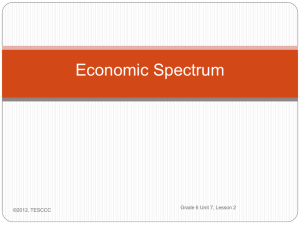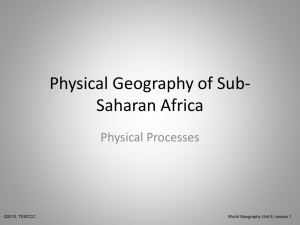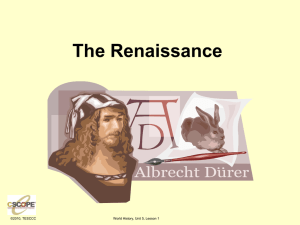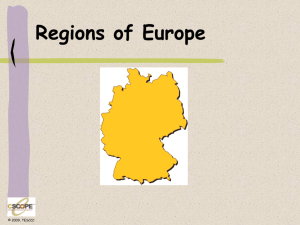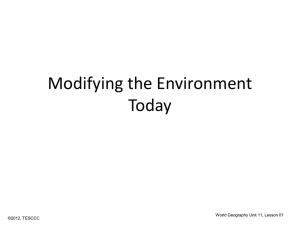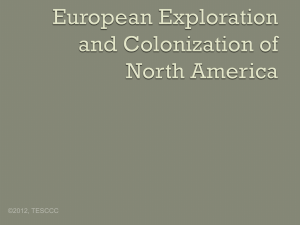EUROPE Regional
advertisement
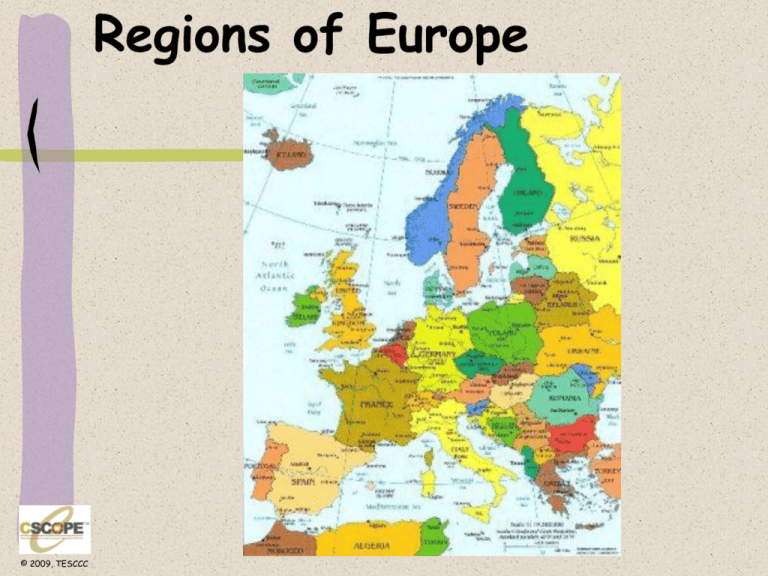
Regions of Europe © 2009, TESCCC Geographic Characteristics Western edge of Eurasia Pervasive world influence Industrialized Numerous nation-states Urbanized population High standards of living in more developed countries East v. West differences © 2009, TESCCC Importance of Location Centrally located with capability of contact with rest of world. Every part of Europe is close to the sea (within 300 miles). Navigable waterways Moderate distances © 2009, TESCCC Generalizations on Climate • Countries closer to warm Atlantic ocean currents and winds have milder temperatures than those farther east and north. • European climates vary according to distance from the sea (idea of continentality). © 2009, TESCCC Biomes and Land Use in Europe Most of Europe is Temperate Mixed Forest, that is typically cleared for farming. Areas of Scandinavia are Coniferous forests while the Mediterranean coastline has scrubby vegetation known as chaparral. Land Use is typically Mixed Farming or Dairy Farming. Mediterranean farming would include the wine industry and olive oil production. Much of the highlands in the British Isles is used for grazing. © 2009, TESCCC AGRARIAN REVOLUTION Began in Europe in the 1750s Based on new agricultural innovations Enabled increased food production Enabled sustained population increase © 2009, TESCCC INDUSTRIAL REVOLUTION Developed in the UK between 1750-1850 Evolved from technical innovations that occurred in British industry Proved to be a major catalyst towards increased urbanization © 2009, TESCCC URBAN TRADITION Urbanization- 73% of Europe is urbanized. Related concepts Primate city- largest city that encompasses the cultural ideals CBD- downtown (business and commerce) Metropolis- terms used to describe central city and suburbs © 2009, TESCCC Supernationalism A venture involving three or more nations Political, economic, and/or cultural cooperation to promote shared objectives New “Euro”Currency © 2009, TESCCC European Union (EU) Original Members: (12) Belgium, Denmark, France, Germany, Greece, Ireland, Italy, Luxembourg, Netherlands, Portugal, Spain, UK Established: 1992 Aimed to coordinate policy among the members in three ways: -- economics -- defense -- justice and home affairs © 2009, TESCCC Supranationalism Problems Loss of autonomy and control Differences in levels of economic development Cultural barriers © 2009, TESCCC Languages In Europe, there are about 50 different languages and more than 100 dialects, most of which belong to the IndoEuropean language family The Slavic languages of eastern Europe, the Germanic languages of northern Europe, and the Romance languages of southern Europe are Indo-European languages. © 2009, TESCCC Religions © 2009, TESCCC - Europe is predominantly Christian. - Most of southern/western Europe’s Christians are Roman Catholics, whereas most northern European Christians are Protestants. - In much of southeastern Europe, Eastern Orthodox Christians predominate. - Many Muslims also live in southeastern Europe (Turkish influence), and Jewish communities exist in all major European cities. Break Between Culture and Environment of Europe © 2009, TESCCC European Regions Western Europe The British Isles Nordic Europe Mediterranean Europe Eastern Europe © 2009, TESCCC British Isles Two Islands: •Britain •Ireland Two Nations: •United Kingdom •Ireland United Kingdom: •England •Scotland •Wales •Northern Ireland © 2009, TESCCC Climate Marine West Coast: Humid, moist Climate that is moderated by warm ocean currents © 2009, TESCCC Historical Geography • Pagan tribes were settled in the British Isles prior to the Roman arrival in the 1st century BCE. Romans remained for about 5 centuries (remnants include Hadrians Wall). •Anglos and Saxons settled as the Romans departed, followed by Nordic tribes (Vikings) in the 9th century, who plundered the Christian churches in the area. •England gets its name from the Anglos or Engles, which were Germanic tribes from the Mainland. © 2009, TESCCC Hadrian’s Wall © 2009, TESCCC Continued Ireland was less affected by the Anglo-Saxons and Nordic tribes Ireland retained its Gaelic heritage. Most Irish were converted to Roman Catholicism in the 5th and 6th centuries (recall St. Patrick) © 2009, TESCCC British Empire Grew in strength throughout the Middle Ages World Conquests: to the Americas, Africa, South Asia (India), SE Asia, Australia, South Pacific. STRONG NAVY The British built a presence in every part of the world. Empire declined during the 20th century © 2009, TESCCC Modern Germany • Suffered greatly after the World Wars from political and cultural conflicts. • Germany is known for its scholarship and hard work ethic. • Welcomes immigrants from all nationalitiesit is now an open, liberal society. © 2009, TESCCC Switzerland and Austria German influenced, although Switzerland is also influenced by Italy and France. Alps- In Western Austria and all of Switzerland. © 2009, TESCCC Northern Europe Denmark (Greenland) Sweden Norway Finland Iceland Estonia* © 2009, TESCCC Physical Geography of Scandinavia • Ice Age glaciers melted here leaving thousands of lakes. • Other glaciers carved out fjords along the coastline. • Jutland, the peninsula on which mainland Denmark lies, is mostly flat. • The Scandinavian Peninsula in northern Europe is mountainous. © 2009, TESCCC MEDITERRANEAN EUROPE •Consists of the Iberian, Italian and Balkan Peninsula •Many islands are associated with this Region. •The Climate is….Mediterranean! © 2009, TESCCC MEDITERRANEAN EUROPE A DISCONTINUOUS REGION ON THE PERIPHERY CULTURAL CONTINUITY DATES FROM GRECO-ROMAN TIMES MEDITERRANEAN CLIMATE HOT - DRY SUMMERS WARM/COOL - MOIST WINTERS © 2009, TESCCC Iberian Peninsula Most of the peninsula is a plateau, but the Pyrenees Mountains form a barrier between it and the rest of Europe. Southwestern Europe’s Iberian Peninsula, home to Spain and Portugal, separates the Mediterranean Sea from the Atlantic Ocean. © 2009, TESCCC ITALY MOST POPULATED OF MEDITERRANEAN COUNTRIES BEST CONNECTED TO THE EUROPEAN CORE MOST ECONOMICALLY ADVANCED DISPLAYS A SHARP NORTH/SOUTH CONTRAST © 2009, TESCCC EASTERN EUROPE Europe’s poorest region Influenced by Russia Many areas have had political and economic instability during the last 2 decades. © 2009, TESCCC UNDERLYING FORCES CENTRIFUGAL FORCES REFER TO FORCES THAT TEND TO DIVIDE A COUNTRY Religious, linguistic, ethnic, or ideological differences CENTRIPETAL FORCES FORCES THAT UNITE AND BIND A COUNTRY TOGETHER A strong national culture, shared ideological objectives, and a common faith © 2009, TESCCC SUBREGIONS OF EASTERN EUROPE COUNTRIES ON THE BALTIC SEA THE LANDLOCKED CORE COUNTRIES ON THE ADRIATIC SEA COUNTRIES ON THE BLACK SEA © 2009, TESCCC COUNTRIES ON THE BALTIC SEA POLAND A CLASSIC NATION-STATE TRADITIONALLY A FARMING COUNTRY LITHUANIA LATVIA ESTONIA BELARUS: Still strongly influenced by Russia © 2009, TESCCC THE LANDLOCKED CORE CZECH REPUBLIC The region’s most westernized SLOVAKIA Less developed, more rural than Czech Republic HUNGARY © 2009, TESCCC COUNTRIES FACING THE BLACK SEA BULGARIA: Freed from Russia in 1878. ROMANIA: Formerly Roman MOLDOVA: Agrarian UKRAINE: Agrarian; largest and most populated of these countries © 2009, TESCCC COUNTRIES ON THE ADRIATIC SEA SLOVENIA: FIRST TO SECEDE; ETHNICALLY MOST HOMOGENEOUS CROATIA: BOOMING TOURISM BOSNIA & HERZEGOVINA: CENTRALLY POSITIONED SERBIA-MONTENEGRO: INCLUDES SERBIA, KOSOVO, AND MONTENEGRO MACEDONIA ALBANIA: 70% MUSLIMS; LOWEST ECONOMIC RANKING IN EUROPE © 2009, TESCCC

